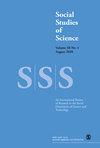手工浮雕模型值得关注:维护、修复、修复山脉?
IF 2.7
2区 社会学
Q1 HISTORY & PHILOSOPHY OF SCIENCE
引用次数: 0
摘要
通过一个被称为“浮雕模型”的案例研究——例如景观区域——本文在实践中接近具象对象。这种方法意味着遵循在具象对象中收集的多种实践,以使它们进入并保持它们的存在,特别是那些通常未被分析性关注所承认的实践。大多数关于表征对象的讨论都集中在它们的表征能力和属性上,而很少关注确保它们作为对象的本体论安全的活动。这些活动不仅涉及具象对象的制造,还涉及它们的维护——这是本次讨论的核心。浮雕模型的维护表现为一种符号-物质生态。纠缠在这里的是工匠的本体论,材料的支持、抵抗和响应,以及表达和指导维护和修复的意义制造和故事。然而,维护这些物品的实践与它们的生产是不同的。它们的产生本质上适应了度量距离,因为表征涉及到通过参考链传递“事物”。相反,它们的维护旨在适应多种暂时性。这不仅涉及到构成物体的每种材料的特定时间方式,还涉及到未使用物体的理想化过去、磨损的现在和预期(修复)的未来。通过玩弄“表征”一词的双重含义,本文思辨性地质疑,维护和照顾表征对象的实践在多大程度上可以告知重新审视和重新思考与它们所要表征的关系-也就是说,什么被视为自然。本文章由计算机程序翻译,如有差异,请以英文原文为准。
Handmade relief models as matters of concern: Maintaining, restoring, and repairing mountains?
Through a case study of what are known as ‘relief models’—for example of areas of landscapes—this article approaches representational objects in and as practice. Such an approach implies following the multiplicity of practices that are gathered in representational objects to bring them into and maintain their existence, especially those that often remain unacknowledged by analytical attention. Most discussions of representational objects focus on their representational capacities and properties, paying less attention to the activities that ensure their ontological security as objects. Those activities concern not only the manufacture of representational objects, but also their maintenance—which is placed at the heart of this discussion. The maintenance of relief models manifests itself as a semiotic-material ecology. Entangled here are the ontological tact of the craftsperson, the affordances, resistances, and responsiveness of the materials, and the meaning-makings and stories that articulate and guide maintenance and repair. The practice of maintaining such objects, however, diverges from their production. Their production essentially accommodates metric distance since representation involves transporting a ‘thing’ through chains of reference. On the contrary, their maintenance aims to accommodate multiple temporalities. This involves not only the ways of being in time that are specific to each material that composes the object but also the idealized past of an unused object, its worn present, and its anticipated (repaired) future. By playing with the double meaning of the word ‘representing’, this article speculatively questions the extent to which practices of maintenance of, and care for, representational objects can inform a re-vision and rethinking of the relationships to what they are meant to re-present —that is, to what counts as nature.
求助全文
通过发布文献求助,成功后即可免费获取论文全文。
去求助
来源期刊

Social Studies of Science
管理科学-科学史与科学哲学
CiteScore
5.70
自引率
6.70%
发文量
45
审稿时长
>12 weeks
期刊介绍:
Social Studies of Science is an international peer reviewed journal that encourages submissions of original research on science, technology and medicine. The journal is multidisciplinary, publishing work from a range of fields including: political science, sociology, economics, history, philosophy, psychology social anthropology, legal and educational disciplines. This journal is a member of the Committee on Publication Ethics (COPE)
 求助内容:
求助内容: 应助结果提醒方式:
应助结果提醒方式:


